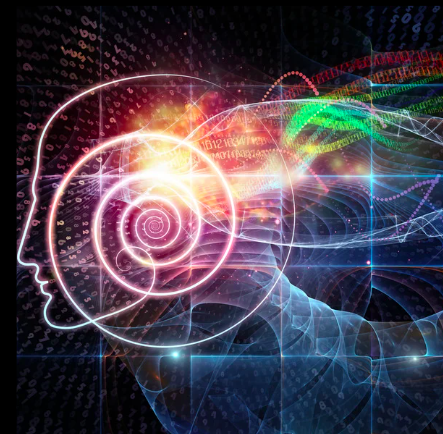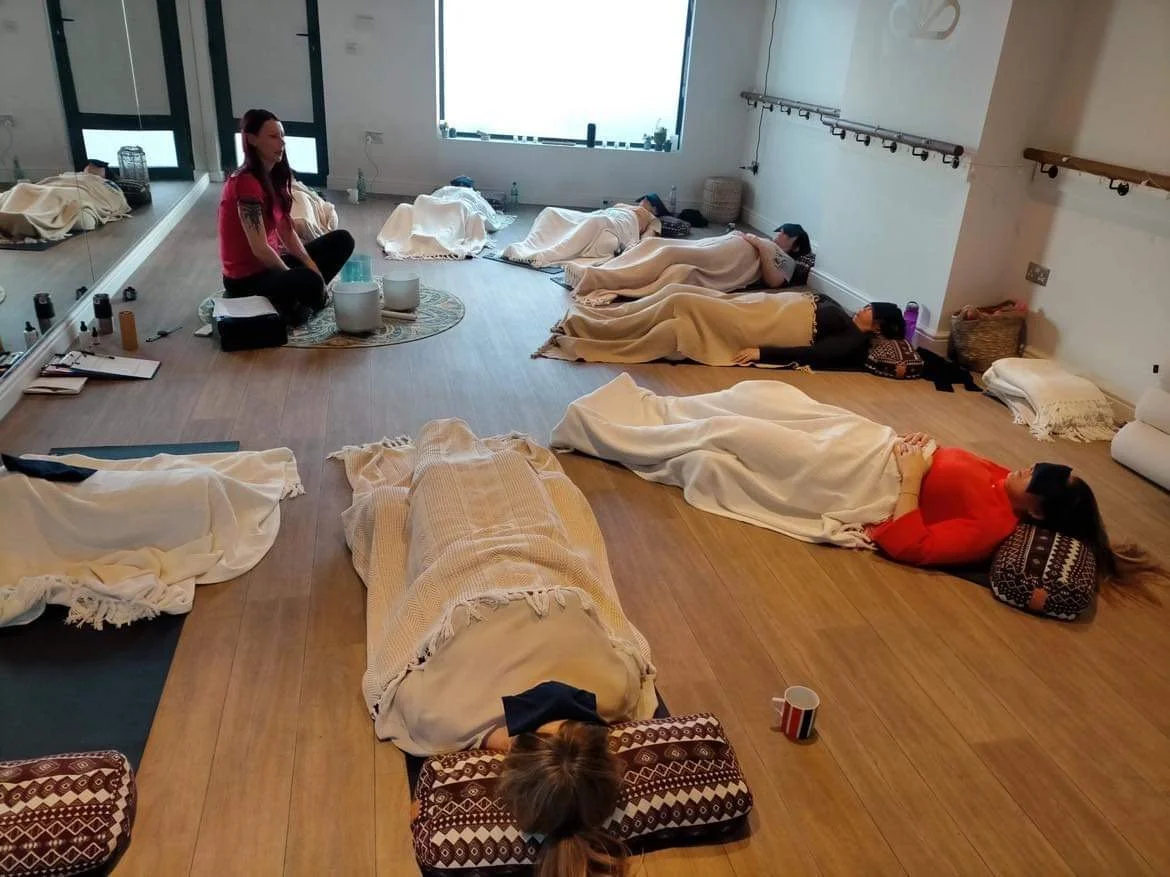blog 5
Yoga Nidra for Beginners
Heard about yoga nidra and fancy giving it a try, but not sure what to expect?
We’ve got you.
In this blog we’re going to tell you everything you need to know to get started.
What is yoga nidra?
Yoga nidra (the sanskrit for ‘yogic sleep’), is a practice of expanded awareness, where you can access a concept called ‘Turiya’ (meaning 'fourth').
Turiya is considered the fourth state of consciousness beyond the common 3 types of consciousness; waking, dream and sleep states.
Fourth State of Consciousness
What happens when you access the fourth state of consciousness?
When in the fourth state of consciousness we are fully present without any attachment to our mind or feelings. There is a timeless quality to this state of being, characterised by being in a state of pure awareness – a profound awareness that isn’t limited by the dualities of existence.
During a yoga nidra practice we are generally in a blend of theta and alpha brainwave states, which means we are deeply relaxed and meditative. We are also able to access elements of delta and gamma brainwaves, where we access our creative and intuitive mind.
This is a unique state beyond ‘ordinary’ awareness, where we are able to access space in our minds, bodies and emotions to rest, heal, access creativity and manifest our heart’s desires.
How will this help me?
Being able to access this liminal ‘in-between’ state of consciousness where we are neither asleep nor awake is a hugely beneficial life hack and can help us in so many different ways, depending on who we are and what we need.
The ability to transport ourself to a place of timelessness not only gives us the capacity to build resilience, presence and calm but it also enables us to be able to flip between extremes at any given moment – which feels a bit like gaining the ability to step out of a busy mind and into the driving seat at any given moment.
In the 1970s, studies found that during nidra we go through the full range of brain range states from beta all the way to delta and everywhere in between. The more we practice this, the more we are then able to do it in every day life.
How does this help in daily life, though?
When we can transport ourselves from an active beta state to a calmer alpha and theta state at will, we have the ability to hack into our own brain and calm ourselves into a more creative/relaxed state of mind.
Being able to make this shift spontaneously is hugely important and can really be a game changer for a lot of people for different reasons.
Let’s look at a few examples:
Provide rest & help you feel refreshed
For people who travel a lot and miss out on important hours of restorative sleep, yoga nidra can provide the rest they need – imagine being able to emerge from an 8-hour flight feeling rested, refreshed and ready for action!
Menopause Support
Nidra’s ability to facilitate movement through various brainwave states can provide menopausal women with tools to manage stress, improve emotional health, enhance sleep quality etc., making it a valuable practice at this stage in life.
Enhanced Creativity
Writers and other creatives also find nidra extremely useful as it enables them to tap into their creative mind more easily.
No more writer’s block!!
Reduces chronic pain
People with chronic pain find that dipping in and out of the brainwave states can lead to profound relaxation, helping to reduce muscle tension and stress, promoting a sense of wellbeing, encouraging healing and reducing the perception of pain.
Addiction Management
The use of visualisation and intention setting can enable people struggling with addictions to manifest resilience and reinforce strength and resolve.
The practice can also enhance sleep quality, access mindfulness and reduce anxiety, all which are helpful tools when managing an addiction.
How do I practice yoga nidra?
There are three ways of practicing yoga nidra:
1 – In studio - in-person one-to-one or group setting. See upcoming classes.
2 – Using a recorded nidra at home.
3 – Using a mental script self learnt and tailored to your own personal goals.
It’s important to try out each different format to see which one works for you.
What happens during a yoga nidra session?
Yoga nidra is very straightforward and you are not expected to do very much – a perfect setting to be able to relax and let go.
Group Setting
In a group setting, you will be laid in comfortable nidra nests on the floor listening to a form of guided meditation.
The facilitator will hold a safe space in order that you can close your eyes (or lower your gaze if that is not comfortable) and completely relax.
Nidra at home
Home setting
At home you can lay wherever is suitable (bed, sofa, mat etc.) and where you will not be disturbed for the duration of the practice and simply make yourself warm and comfortable.
Know that your body temperature will drop slightly during the practice so it can be good to have a blanket close to hand as well as one on top of you to begin.
You might want to use headphones of airpods to listen to a recording of yoga nidra on your phone or computer, or you might prefer it on speaker.
What’s a typical nidra sequence?
Each yoga nidra will follow a general sequence – explained below – but there will be variations in different nidras, depending on the length and the purpose or theme of the nidra.
Build your nidra nest
You will be invited to settle first of all, building yourself a comfortable nest using blankets, bolsters and cushions and to turn the senses inwards.
Breathwork
There might be some elements of breath work early on in the practice in order to down regulate the nervous system and to shift into the body closing down the external senses.
Lay in ‘shavasana’
You will then be invited to lay in ‘shavasana’ (Nidra is usually practiced in the yoga pose ‘shavasana’ but if you prefer a different posture that is fine too).
Once settled you will be invited to listen, as little or as much as you wish, to the voice leading you through the various stages.
Ideally you will stay still during the practice but it is perfectly normal to want to wiggle and adjust your position throughout the practice. This is welcomed. Some people lay on their front, some on their side or even their front. It is completely a matter of preference.
Set a sankalpa
You will then be invited to set a sankalpa or an intention for the practice – this is a bit like a manifestation of what you might like to see/be/achieve etc. You will repeate the sankalpa to yourself at various points throughout the practice to help guide you towards the correct path and help you to manifest what you wish to happen.
A sankalpa can be very useful in trying to change our behaviour, e.g. overcome addiction etc.
Body rotation
Sense withdrawal and a guided body rotation will then guide you further inwards into a state known as ‘prayahara’ where we turn our attention inwards.
Opposites & Visualisations
Play with opposites and visualisations will then take you further into the deeper brainwaves states. This is where you access your intuitive wisdom and the deeply nourishing healing happens.
Return to externalisation
Return to the sankalpa, then externalisation and the end of the practice.
What happens at each stage and how does it help me?
Here’s a more detailed look at the stages of the nidras we deliver at Revival Nidra, what happens in each stage and how it helps you.
Stage 1 - Preparation & Setting
What we do – We guide you into a state of comfort and relaxation. Koshi bells are often used at this stage for their calming effect.
What happens – You start to move through the different brainwave stages, coming out of the everyday state and into a state of relaxation.
How does this help you – Relaxation starts to occur. Any emotional distress starts to disappear.
Stage 2 - Sense Withdrawal
What we do – We guide you through the senses towards a more intuitive state of awareness.
What happens – ‘Pratyahara’ – takes you out of your external senses, as you start to focus inwards.
How does this help you – You enter an introspective state, which quiets the mind.
Stage 3 - Sankalpa
What we do – We give you time to consider your intention for the practice.
What happens – You repeat the sankalpa 3 times, setting your intention.
How does this help you – You begin to work towards your desired goal or positive change.
Stage 4 - Rotation of consciousness
What we do – Various forms of rotation are used in our sessions sculpted around the theme of the session.
What happens – The Sympathetic nervous system (SNS) is deactivated and the parasympathetic nervous system (PNS) is activated.
How does this help you – It relieves physical and emotional tension.
Stage 5 - Opposites
What we do – A guided visualisation of opposites relevant to the specific theme.
What happens – Both sides of the brain are engaged promoting pratyahara.
How does this help you – You enter your intuitive wisdom.
Stage 6 - Visualisations
What we do – Deeply visual explorations of themes ranging from a story format to a series of images and everything in between.
What happens – This is where you delve deep into the lower brainwave states.
How does this help you – Deep nourishing healing happens.
Stage 7 - Externalisation
What we do – Prepare to return to a normal state gently and gradually using a journey through the senses and gentle sounds.
What happens – You gradually return to the external senses.
How does this help you – At the end of the practice you will feel calm, relaxed and often refreshed.
For more information on the Stages of Nidra go to Blog 2 (Yoga Nidra Explained).
What to expect
Stage 1 and 2 are about down regulating the nervous system and during this time you will feel a gradual shift from being up and active into rest and digest mode. You may notice the stomach gurgling, saliva in the mouth and thoughts starting to slow down.
During stage 4, 5 and 6 your mind will shift into the liminal space between being awake and asleep and you will feel yourself dropping in and out of a dream-type state. Here you may see interesting dream-like visualisations, which many people really enjoy. Some people may have involuntary twitches at this time times, which is thoughts to be a shifting of energy, the processing of emotional blockages and stress and the body beginning the healing process.
Falling asleep is OK
What if I fall asleep?
Although the direct translation from sanskrit is ‘yogic sleep’, yoga nidra isn’t sleeping. It is more about entering the liminal space between being awake and asleep.
That said, it is a very relaxing practice and sometimes people do fall asleep. But is that ok? Will you still get the benefits from the practice if you do?
Practitioners vary in their response to this, and some offer the option of a gentle hand on their shoulder to wake them up, if they fall asleep.
This is not something we do at Revival Nidra as we believe that the body takes what it needs from the practice and if the body needs sleep then it should be allowed to do so.
Those that fall asleep during the practice (and there is always more than one!) will generally drift in and out of sleep and will still get the benefits of all the stages of the practice.
Who can benefit from the practice and who might it not suit?
Yoga nidra is accessible to anyone, with or without experience of yoga and meditation and most people can benefit from the practice.
Nidra can help provide relief from many different problems, including:
- stress and anxiety
- pain management
- helps overcome addictions
- helps improve quality and amount of sleep
- helps heal from trauma
- lowers blood pressure
- S.A.D
Caution should be exercised with those who are suffering or have a tendency towards psychosis or those with severe trauma but if the facilitator is aware of the nature of the trauma, the nidra can be designed with this in mind.
People who suffer from chronic pain, in particular back pain, are not suited to lying on hard surfaces for long periods of time as a group glass would usually entail. But adjustments can be made to enable these participants to access the class, so just let the facilitator know beforehand so that a nidra can be tailored accordingly.
What do I do next?
If you’re ready to try your first yoga nidra, please get in touch. We’d love to help you with your practice.
You can attend an in-person class session – see upcoming events for details and how to book.
Or you can try it out at home with one of our online nidras. Look out for more of these coming soon.
Good luck, we hope you enjoy your journey!










